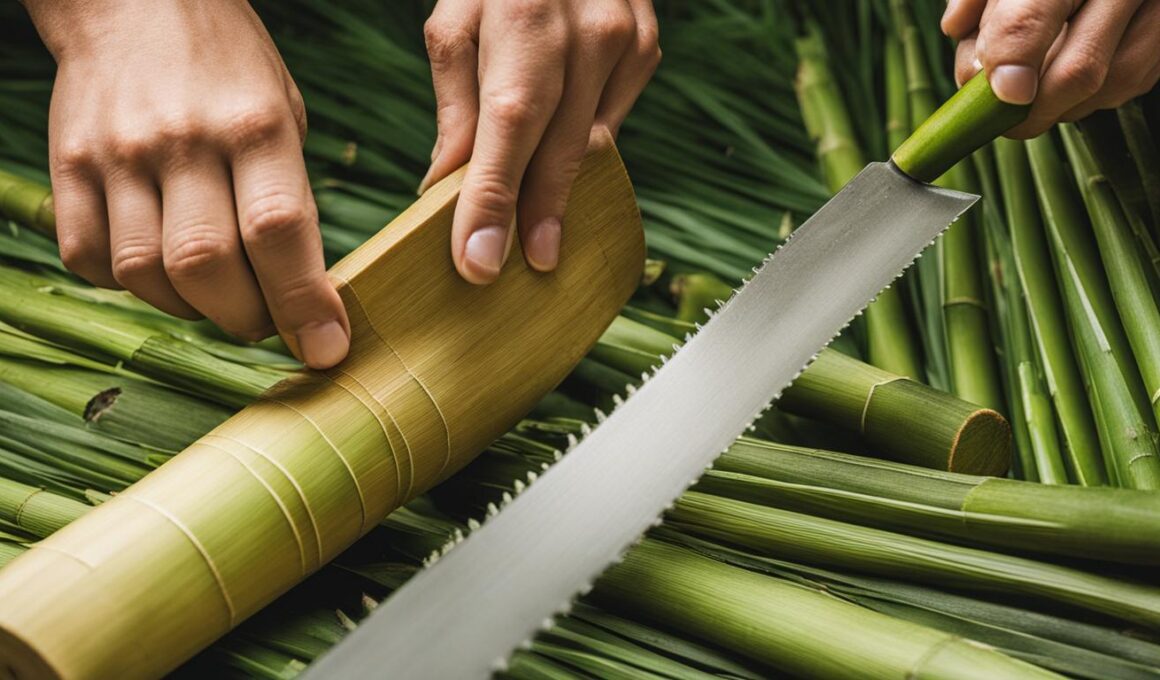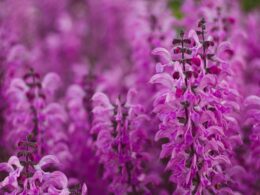Are you looking to cut bamboo for your next project or to maintain your bamboo plants? In this step-by-step guide, we will walk you through the techniques for cutting bamboo, ensuring clean and efficient cuts every time.
Whether you’re working on a craft project or tending to your bamboo garden, knowing the right cutting techniques is essential. By choosing the right cutting instrument, finding the nodes on the bamboo stalks, and lubricating the bamboo before cutting, you can achieve precise results.
When it comes to projects with bamboo, using the correct tools and methods is crucial. We’ll provide you with tips on cutting bamboo stalks for crafts, including advice on choosing the right type of bamboo and preventing splintering during the cutting process.
Maintaining bamboo plants in your garden requires proper pruning techniques. We’ll guide you through the process of pruning and maintaining bamboo, ensuring the health and appearance of your plants. Learn when to prune, which tools to use, and the importance of trimming bamboo stalks in a safe and effective manner.
If you’re interested in propagating bamboo, we’ve got you covered too. Discover how to clone bamboo and grow new plants from cuttings. We’ll share the necessary steps, including selecting the right bamboo stalks for propagation and planting them for successful growth.
Whether you’re a DIY enthusiast or a gardening enthusiast, this comprehensive guide will provide you with all the information you need to confidently cut bamboo and maintain its beauty.
Cutting Bamboo Stalks for Projects
When it comes to using bamboo for your creative projects, knowing how to cut bamboo stalks properly is essential. Whether you’re making crafts, furniture, or decorations, following the right techniques will ensure clean and precise cuts for your bamboo pieces. Here are some helpful tips to guide you:
- Choose the right bamboo: For crafting purposes, it’s best to work with green bamboo stalks. They are more flexible and easier to cut compared to dried or aged bamboo.
- Use the right tools: For stalks less than 1-inch in diameter, a sharp pruner will suffice. However, for thicker stalks, you’ll need a sharp handsaw. Ensure your tools are clean and well-maintained for optimal performance.
- Prevent splintering: Before making your cuts, apply masking tape around the area where the cut will be made. This helps prevent splintering and ensures a smoother finish.
- Find the nodes: Nodes are the joints or sections where the bamboo stalks connect. They provide strength and support to the bamboo. When cutting, make sure to identify the nodes and work around them.
- Lubricate the bamboo: Before cutting, consider lubricating the bamboo stalks with a suitable lubricant or oil. This will make the cutting process smoother and reduce the chances of splintering.
- Optimal working conditions: Working in a room temperature environment is recommended when cutting bamboo. Extreme cold or heat can affect the flexibility and durability of the bamboo stalks.
By following these tips, you’ll be able to cut bamboo stalks effectively for your various craft projects. Remember, attention to detail and precision will result in high-quality finished products that showcase the beauty and versatility of bamboo.
Pruning and Maintaining Bamboo Plants
Bamboo plants require regular pruning to ensure their health and appearance. By pruning your bamboo plants, you can promote better growth, control their size, and maintain their overall aesthetic appeal. Here are some essential guidelines for pruning and maintaining your bamboo plants:
- Timing: Pruning is best done after the 3rd to 5th growing season. It is important to avoid pruning during the shooting season.
- Tools: To prune a bamboo stalk effectively, you will need a hacksaw or a similar cutting tool. Remember to wear safety gear, such as gloves and goggles, to protect yourself.
- Technique: When pruning, make sure to cut above a node, which is the joint where the leaves and branches emerge from the stalk. This will ensure that the remaining stalk continues to grow and support new foliage.
- Grooming Bamboo Branches: Apart from cutting the stalks, it is beneficial to groom the branches of your bamboo plants. This involves removing any dead, damaged, or crossing branches to improve airflow and sunlight penetration.
- Topping the Bamboo: Topping involves cutting the top portion of the bamboo stalk to promote lateral growth. This technique is useful if you want to shape your bamboo or encourage branching.
By following these tips for pruning and maintaining bamboo plants, you can ensure the long-term health and vitality of your bamboo garden. Regular pruning not only keeps your bamboo looking neat and attractive but also helps prevent diseases and pests from taking hold. Remember to exercise caution when working with sharp tools and always prioritize your safety.
Propagating Bamboo through Cuttings
If you’re looking to expand your bamboo collection or start a new one, propagating bamboo through cuttings is a simple and effective method. Younger bamboo stalks are ideal for propagation, as they have a higher success rate. To ensure successful propagation, make sure your cuttings have at least two full internodes and two half internodes.
Once you have your bamboo cuttings ready, it’s time to plant them in the soil. Place the cuttings in the soil with one or two nodes covered, ensuring they are firmly planted. Keeping the soil damp is essential for root growth, so make sure to water regularly. Planting your bamboo cuttings during the wet months can further enhance the success rate of propagation.
It’s important to note that not all types of bamboo can be propagated through cuttings. Distinguish between true bamboo and lucky bamboo, as the latter is not suitable for propagation through cuttings. With proper care and attention, you can enjoy the satisfaction of growing new bamboo plants from cuttings and expanding your bamboo garden.
Is there a specific way to store bamboo after cutting it?
After cutting bamboo, storing leeks properly is essential for maintaining its quality. To store bamboo effectively, place it in a dry and ventilated area, away from direct sunlight. Alternatively, you can submerge the cut ends in water, like storing leeks properly, to keep it hydrated and prevent decay.










